|
HEAVY EARTHQUAKE in SOUTHEAST IRAN
An enormous earthquake occurred in the Lut Desert, southeast of Iran, before the dawn of December 26 in 2003 and the city of Bam near the epicenter fell into a state of devastation. The death toll seems to rise to 40,000, a third of the population of Bam and its environs.
There are numerous sorts of disasters that assault the world incessantly. Among others, great earthquakes occur almost every year somewhere in the world, each time several thousands or tens of thousands of people are killed. Recently Japan had the South Hyogo prefecture Earthquake in 1995, while three years ago in India the great earthquake in Gujarat, India, claimed more than 20,000 lives and the city of Bhuji near the epicenter suffered devastating damage. Two years before that, there was an enormous earthquake in Turkey too, killing approximately 17,000 people.
This time, the Iran Earthquake has brought a great disaster to the ruins of Bam, a historical ghost town around a citadel in the desert area. I will expound what the ruins of Bam are like from the architectural point of view.
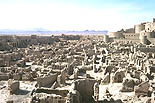 
Left : View of the town and Citadel from the eastern city wall
Right : Looking down on the town from the Citadel
A large part of Iran's territory is desert like many other countries in the Middle East. However, even in deserts there are inhabitants and there are villages and cities. East-west trade has been practiced through those deserts by camel caravans since the remote past, forming cities as transit stations in the deserts. Among them greatly thriving cities grew by levying tolls on caravans and trading to supply foods and goods to them like Palmira in the Syrian Desert or Jaisalmer in the Thar Desert of western India.
There are two primary factors to form such a desert city: being an oasis blessed with underground water and the existence of a hill to build a fortress in defense of the city. Bam met the conditions. Similarly to Jaisalmer, they converted the hill into a citadel and constructed a town at the foot, surrounding the whole with a continuous fortified wall.
They could also cultivate oranges and date palms in the adjacent fields thanks to the groundwater from old times. The current verdurous oasis close to the ruins makes a vivid contrast with the monochromatic earth colored fortified city.
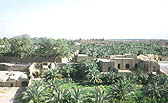
Bam as an Oasis city
However for planting trees in such a vast area the underground water in Bam is not enough. Like many other Iranian villages and towns, they have been using 'Qanat' (subterranean aqueduct systems) that brings water from distant mountain for miles. The earthquake of this time has damaged those qanats too so bitterly that the cultivation of dates and oranges will be impeded extremely.
HISTORY of THE CITY OF BAM
The origin of Bam goes back to before the Common Era and seems to have been a sacred town possessing a fire temple of Zoroastrianism. It was in the age of Sasanids from Persia (the 3rd to the mid-7th centuries) that Bam was established as a fortified city. Conquered by Arabs in 642, the city was Islamized. Pillaged by the Seljuks in the 11th century, demolished by Timur's army from Mongolia in the end of the 14th century, invaded by Afghans in 1722, the last king of Zand dynasty, Karim Khan, took refuge here in 1794 but was destroyed by the pursuit of Aqa Muhammad from the Qajar dynasty and a lot of residents seemed to have been killed.
Thus Bam has suffered in abundance, but it was reconstructed each time. So there is nothing made before the 16th century among the current existing remnants. It can be said that this earthen town is vulnerable compared with masonry towns, while relatively easier to reconstruct.
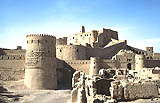 Soaring Citadel on the hill
Soaring Citadel on the hill
Due to the lack of timber, all buildings have been built of sun-dried bricks. If there is a culture of wood in Japan and that of stone in Europe, there has been an uninterrupted 'culture of earth' in desert areas in the Middle East.
In order to build a roof with sun-dried bricks (mud-bricks) made of clay mixed with fibers (or baked bricks if there are timbers as fuel) it was integral to invent the 'arch' structure. It was in Mesopotamia (current Iraq and Syria) that the arch, barrel vault, and dome structures were invented in the 20th to the 30th centuries C.E. This technology made possible to construct any edifices, however large, by piling up small bricks.
Since the city of Baghdad, famous from the "Thousand and One Nights," was also constructed of earth in 762, once abandoned it returned to earth without leaving any trace. The current capital of Iraq is the new Baghdad constructed long afterword.
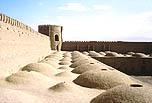
Roofs of buildings surrounding a large courtyard
The city of Bam had been abandoned as well since 150 to 200 years ago with unknown reason and was returning to the ground gradually due to the elements when I visited. What is currently called Bam, a short distance away is the new Bam formed in modern times.
As in Goa, India, Old Goa (Goa Velha) was forsaken owing to an epidemic of cholera or malaria and New Goa (current Panaji) was constructed on the coast, Old Bam (Arg-é Bam) might have been abandoned because of the vehemence of a contagious disease.
It is said that in the early 20th century the town was used as an army barracks, but it was completely forsaken by 1932 and left to desolation. Nonetheless since it was not destroyed by a war, old Bam completely preserves the city composition in the age of the Safavid dynasty (the 16th to the 18th centuries).
The reason that the city could survive for more than 150 years is that there was few rainfall in this area. There is no rival to show the 'culture of earth' so distinctly so I always project slides of Bam every time I lecture on the Earth Culture in the university.
President Khatami of Iran declared that he intended to reconstruct the urban area as well as restore the ruins of Arg-é Bam.
 Aerophoto of Bam enclosed by City walls
Aerophoto of Bam enclosed by City walls
The upper part is Citadel, the lower part is Urban district
(From Iranian Cities, Heinz Gaube, 1979, New York University Press )
PEACE CONSTITUTION and DISPATCH of TROOPS
As I visited this town in May 1980, it has been twenty-four years. It had not yet become a popular tourist site. Roam in the ghost town with collapsing earth buildings regularly standing along the streets without a single person, it was a bit eerie.
After that buildings were gradually restored or rebuilt and the town became a tourist spot. Although the government of Iran seemed to intend to apply the registration to the UNESCO World Heritage List, Arg-é Bam was seriously damaged by the earthquake this time.
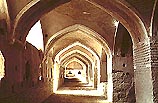
Interior space of a building in the Citadel
The time I entered Iran from Turkey by road was just after the Islamic Revolution and the beginning of a skirmish (it would soon become the full-scale Iran-Iraq War), I was warned not to go to Iran by the Turkish government tourist office in Istanbul.
The embassy of the U.S.A. in Teheran had been occupied by Iranian students and all of the embassy staff had been taken as hostages. An American helicopter with a duty to rescue them crashed a short distance before arriving at the embassy building. It is exactly on that day that I crossed the border to Iran.
No foreign tourists were seen and in every town women in black chadors were demonstrating on the street, yelling 'Death to America.' But there was no danger for Japanese and I was welcomed everywhere. All Iranian people liked Japan.
When I stayed a night in Bam, an Iranian who happened to hear a Japanese person was staying in this town came to see me in my hotel. Knowing that I was going to Zahedan, he found a car going there and arranged to let me go with them.
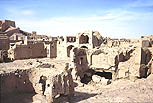 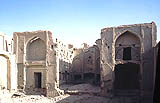
Half collapsed buildings
Thanks to the Japanese Peace Constitution, the Japanese do not encounter a hostillity but have been welcomed everywhere in the world. Conversely the Americans have been disliked everywhere in the Islamic world. One of its origins is the attitude of the USA on Palestinian issues.
During the Gulf War I traveled in Algeria and Tunisia. When I arrived at a hotel in Algiers, a receptionist asked me first of all if I was pro or con towards the USA, intending not to let a pro stay, though as a joke. While Japanese newspapers were in chorus blaming Saddam Hussein in Iraq, people's emotions in the Islamic countries were to support him and feel hostile towards the USA.
However, the Japanese government is now on a direction to betray its Peace Constitution to send troops to Iraq, following an alliance with the USA. It is about to dismiss the feeling of the confidence of the countries that are beyond the differences of religions and political structures, which Japan has built so far.
An important difference of Islam from other religions is that the religion is superior to the state. People have a stronger feeling of solidarity as a member of the Islamic world (Dar al-Islam) than as a resident in a state. If Japan points a gun at Iraq people, it would mean making the whole Islamic world an enemy.
The Peace Constitution is a Japanese cultural heritage that the nation should be proud of before the whole world. It is a living world heritage still now, more valuable than Himeji Castle or Horyuji Temple. To send troops abroad in contravention of the constitution would be as grievous an act as the great earthquake that has destroyed the city of Bam.
(30/12/2003)
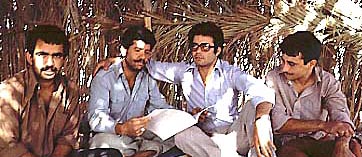 Young folks with a liking for Japan, have they survived ?
Young folks with a liking for Japan, have they survived ?
I revisited Bam for the first time in 28 years, 3 years after the earthquake.
 
Arg-é Bam under restration, March 28, 2007
|